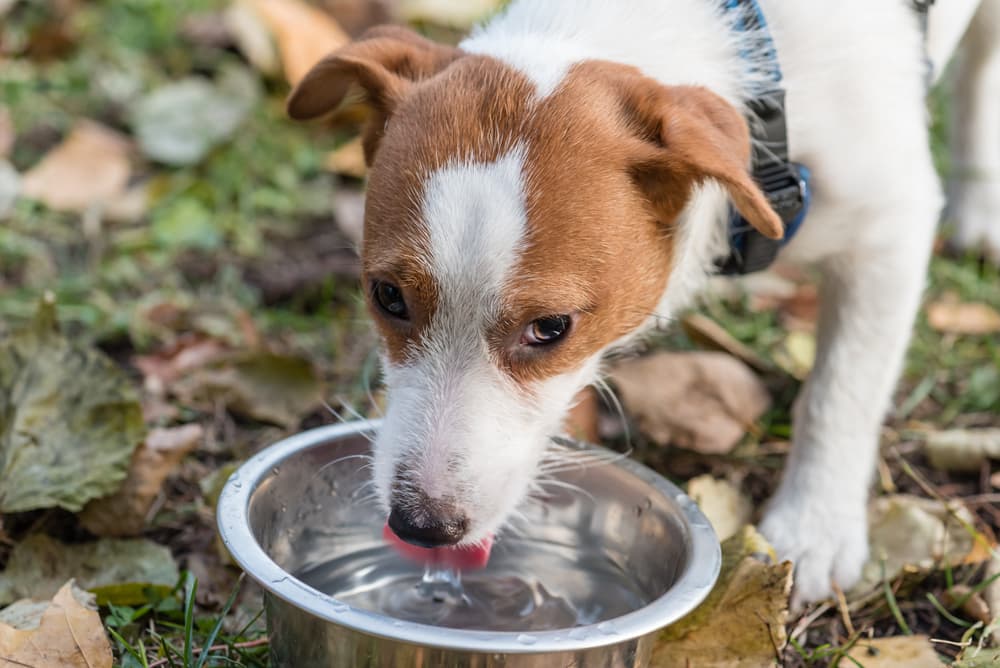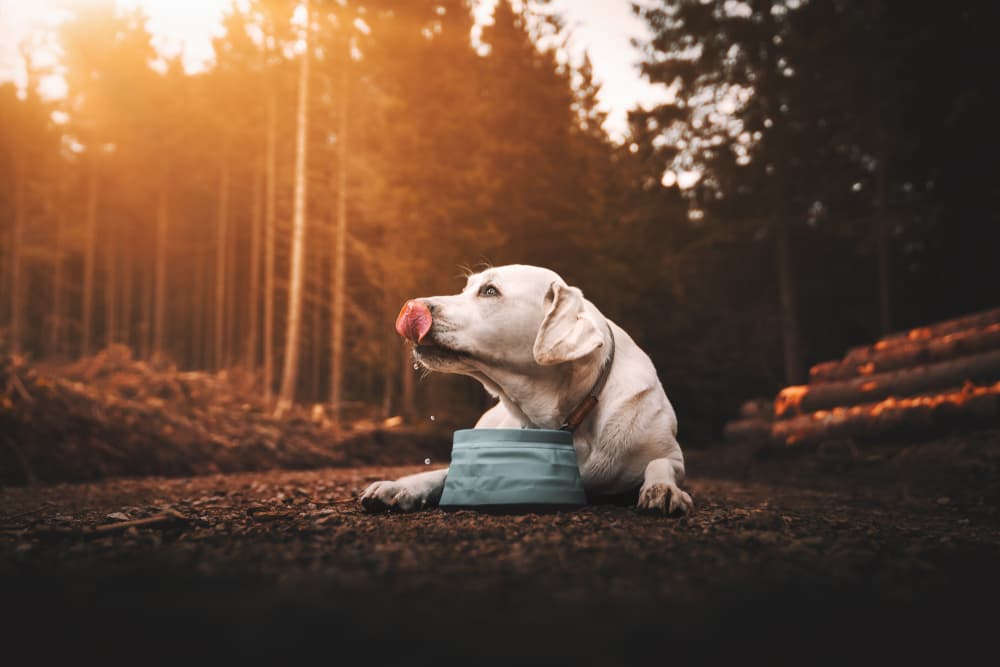How Much Water Should a Dog Drink?

Water. You know your dog needs it. After all, you fill up his water bowl every day. But why is water so important? And how much water should a dog drink? It seems like a simple enough concept, but understanding why dogs need to drink water and how much they should typically drink during the day will help you keep your dog healthier and happier.
Like humans, a dog’s body is made up of about 70-80 percent water, according to Dr. Jim D. Carlson, owner of the Riverside Animal Clinic in McHenry, Illinois. “Just like us, dogs need to stay hydrated to digest food, carry important fluids through the body, and remove toxins,” he says.
Water does a lot for a dog’s body. Water delivers vital nutrients and assists with the digestion process (including eating, absorbing nutrients from food, and moving waste through and out the body). Water helps a dog regulate his body temperature and allows the vital organs to function optimally.
When a dog is well-hydrated, the body operates in peak form. When a dog does not drink enough water, or if he loses water due to illness like vomiting or diarrhea, he risks becoming dehydrated. Without enough water, a dog’s organs can’t function and eventually, will fail.
How Much Water Do Dogs Need in a Day?

If you know how much your dog weighs, you can easily calculate how much water he should be drinking every day.
“Dogs need, on average, 1 ounce of water per 1 pound of body weight per day,” says Dr. Gary Weitzman, CEO of the San Diego Humane Society and author of the National Geographic Complete Guide to Pet Health, Behavior, and Happiness: The Veterinarian’s Approach to At-Home Animal Care . “This varies depending on activity level, ambient temperature, and excitement, because panting will dehydrate your pup.”
Breed, age, body condition, and medications also influence how much water your dog needs.
Small dogs will drink a smaller volume of water per day compared to large dogs simply due to their difference in size. A 5-pound dog should drink about 5 ounces of water each day and a 50-pound dog should drink about 50 ounces of water daily.
There are instances where some dogs need more than one ounce of water per pound of body weight. “Younger dogs have increased water requirements because they are growing and developing,” Carlson says.
Dogs might also need more water when it’s very hot out, after exercising and after excited play.
Why Is My Dog Drinking So Much?

If your dog is suddenly drinking more water than he usually does, is it cause for concern?
Sometimes, a slight increase in water intake is normal. If your dog has been exercising more than usual, he might feel extra thirsty. Many dogs drink more water in the summer when it’s hot and they are panting more often.
Certain medications like prednisone can also cause increased thirst. If your dog is taking a new prescription and you notice an increase in his water consumption, let your veterinarian know right away.
But other times, excessive water consumption (often followed by your dog urinating more) is a clue that a dog has an underlying health issue. “Kidney disease, diabetes, Cushing’s disease, and urinary tract infections are the most common reasons for increased thirst and urination,” says Carlson.
Is My Dog Drinking Too Much Water?

A simple way to find out if your dog is drinking too much water is to measure your pup’s daily intake.
Start the day with an empty water bowl. Fill a separate container with the amount of water your dog should drink in a day and use that container to fill up his water bowl throughout the day. If your dog weighs 40 pounds, for instance, fill a jug with 40 ounces of water. If your dog drinks all of the water and you need to refill your dog’s bowl more than once in 24 hours, it’s worth a visit to the veterinarian to have your dog checked out. This method may not be accurate for messy drinkers and houses with multiple pets who drink from the same bowl.
You can also take a close look at your dog’s urine—both the amount and the color. A dog that is drinking too much water will be urinating much more frequently than normal (and may be having accidents in the house). Dogs that are drinking too much water will also have very diluted urine that will look very pale yellow or even clear. Usually the first morning urine of a dog is the most concentrated while later in the day urine color and odor is more variable.
Why Is My Dog Not Drinking Water?

What if your dog is not drinking the recommended amount of water each day? There could be a variety of reasons. Dogs that are sick often don’t feel like eating or drinking. If your dog’s reduced water intake is sudden, take him to the veterinarian for an exam.
Often though, dogs may simply lack interest in drinking, either because they don’t feel thirsty or because they are picky about the taste or temperature of their water, or the location of their water bowl.
If you notice this pickiness, try refilling your dog’s water bowl with clean, fresh water or move the water bowl to a different location. If that still doesn’t entice him to drink, reach out to your veterinarian to discuss options.
How to Help Your Dog Get the Right Amount of Water

Staying hydrated is vitally important to your dog’s overall health. Even low levels of dehydration can be taxing on your dog’s organs. Additionally, dogs with certain medical conditions like kidney disease or urinary stones need to remain well hydrated to stay healthy. On the flip side, drinking too much water is also hard on a dog’s body, and can lead to accidents in the house.
Luckily, there are some steps you can take to help entice your dog to drink more water and also to curb excessive water consumption.
If Your Dog Isn’t Drinking Enough
“You can encourage your dog to drink more water by making sure the water is easily accessible, ensuring it’s clean and fresh, cooling the water (cold water is more palatable for both humans and dogs), and possibly raising the water bowl on a stand, depending on the size of your dog,” Weitzman says.
Some dogs enjoy drinking from pet fountains, which keep the water cool and fresh tasting. You can also try adding a splash of low-sodium chicken broth to your dog’s water to tempt him to drink more.
If you feel like your dog still isn’t drinking enough, ask your veterinarian about whether adding wet food to your dog’s diet can help. “Feed at least 25 percent of the diet as wet food and the dog will increase their water intake through the food,” advises Carlson.
If Your Dog is Drinking Too Much
If your dog is drinking and urinating more than usual, the first step is a visit to the veterinarian.
“If your dog drinks a lot more than an ounce of water per pound of body weight per day, it might signal a health issue,” Weitzman says.
If your dog takes prescription medication and suddenly starts drinking more water, your veterinarian might want to adjust the medication or try something different. Give your veterinarian a call right away.
If your dog gets a clean bill of health, ask your vet if it’s okay to pick up the water bowl a few hours before bedtime to cut down on nighttime bathroom breaks and unnecessary water consumption.
Monitoring your dog’s water intake is an important part of tracking their health. Noticing a change, like increased thirst, early can help protect your pet’s health.









